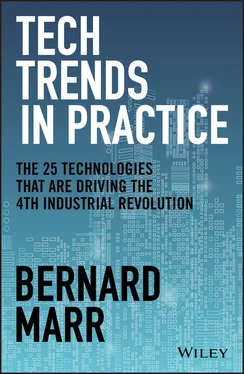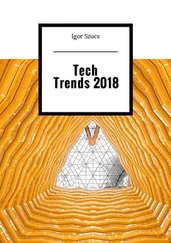Edge computing is just one of the advances we can look forward to in the IoT, but it’s by no means the only one. As businesses quickly cotton on to the power of the IoT, expect many more exciting IoT-related developments in the coming years.
How Is the Internet of Things Used in Practice?
The IoT is set to become even more deeply embedded in our everyday lives: at home, at work, and when we’re on the move. In fact, you might be surprised how deeply entrenched it is already. Let’s look at some of my favorite real-life examples of the IoT in action.
Making Our Homes and Everyday Lives Smarter Through Intelligent Consumer Goods
Unlocking your front door with a boring old key? No need, if you have a smart front door lock. Turning light switches on and off with your actual hands? What are you, a cave dweller? The idea behind many smart consumer goods is to simplify (and even automate) those mundane, everyday tasks. What’s more, the best of today’s smart products get to know your preferences and behavior, so that they can anticipate your needs and respond to your behavior. For example:
Google-owned Nest’s learning thermostat tracks how you use your home so that it can regulate your home’s temperature accordingly.
The Orro intelligent light switch can tell when you’re in the room and switch the lights on and off without you having to do anything. It’ll also adjust the lighting based on the time of day.
The August Smart Lock Pro allows you to lock and unlock your home from anywhere, without a key. It automatically locks the house when you leave and unlocks it when you come home and can integrate with voice assistants like Alexa and Siri.
LG’s smart wine fridge can tell you what food to pair with your tipple, and recommend which wine to buy next, based on what it learns about your tastes.
LINKA’s smart bike lock recognizes you as you approach and automatically unlocks your bike, without a key. You can also grant remote access to your bike to family and friends.
You can even get smart toilets these days. No really. The Kohler Numi 2.0 Intelligent Toilet comes with built-in Amazon Alexa – a snip at $8,000.
Wearable devices such as smart watches, fitness trackers, and even smart clothes make up a critical part of the IoT. Read more about the wearables trend in Chapter 3.
Making People Healthier with the Internet of Medical Things (IoMT)
The IoT is poised to transform the healthcare industry, giving rise to its own name: the IoMT. These IoMT devices can be used to help monitor patients, inform caregivers in the event of an emergency, and provide healthcare professionals with data that could inform diagnosis and ensure patients follow doctors’ orders. For example, IoMT devices can track vitals and heart performance, monitor glucose and other body systems, and track activity and sleep levels. Think about the impact of this for a second – instead of doctors relying on what the patient tells them, the IoMT gives healthcare providers an incredible insight into what’s really going on with the patient’s health and lifestyle. As you can probably imagine, the IoMT is closely linked to the rise of wearable technology (see also Trend 3).
Transforming the Way We Do Business
The IoT offers huge benefits to businesses. There are some great examples of this.
For companies that make and sell products, making those products smart can deliver unprecedented insights into how those products are used. Thanks to these insights, companies can deliver a better service and improved products. Rolls-Royce, for example, installs sensors in the jet engines it manufactures, so it can better understand how airlines use those engines.
The IoT also gives businesses the chance to deliver new customer value propositions. For instance, tractor and farm equipment manufacturer John Deere has developed intelligent farming solutions where sensors continuously monitor soil health and other factors, and give farmers advice on what crops to plant where, and so on.
Companies are also generating new income streams, thanks to the IoT. Google’s Nest smart thermostats are one example of this. The thermostats collect real-time energy usage data from customers – data that’s incredibly valuable to utility companies and other interested parties. In this way, data generated from IoT devices can become a key business asset, and potentially bolster the company’s value.
For many companies, the biggest IoT opportunities lie in the ability to improve and optimize operations. Data generated from smart machines – for example, manufacturing equipment – can be used to improve the way the company is run, potentially automate various processes, drive efficiencies, improve reliability, reduce costs, and so on. It’s no surprise, then, that manufacturing and industrial companies have been leading adopters of IoT technology, which brings me to…
Introducing the Industrial Internet of Things (IIoT)
Companies are increasingly seeing the value in connected machinery that is capable of reporting every detail of operations – and this network of connected industrial devices is known as the IIoT. Examples include:
Robotics and automation company ABB used connected IIoT sensors to monitor its robots’ maintenance needs, so it can carry out repairs and maintenance before parts break.
Automobile parts manufacturer Hirotec used IIoT technology to monitor the reliability and performance of machinery at one of its tool-building operations. The data was used to make machines more productive. The company is now focusing on connecting a whole production line at one of its manufacturing plants in Japan. This means the production of a complete auto component – in this case, a car door – will all happen in a smart, connected way. 3
The IIoT is even helping trains run on time. Siemens AG gathers data from sensors on trains and rail infrastructure to, among other things, carry out predictive maintenance and increase energy efficiency. As a result, the company says it can now guarantee almost 100% reliability for its customers. 4
Field service management provider ServiceMax has created an IIoT-driven platform called Connected Field Services to help companies implement predictive maintenance for their mobile and offsite equipment. Eventually, ServiceMax hopes the platform will help guarantee 100% uptime availability for mission-critical equipment. 5
Wireless devices the size of a grain of salt that are equipped with tiny sensors and cameras? Already a reality. Microelectromechanical systems (MEMs, or motes, as they’re sometimes called) are very real and have the potential to multiply the IoT millions or billions of times over. 6In the future, MEMs may be used in settings like agriculture, manufacturing, and security, as well as in robotics (Trend 13) and drone technology (Trend 19).
Privacy is one concern with IoT devices – how much of our activity and behavior do we really want monitored, especially in our own homes? Many people appear happy to forgo their privacy in return for a smarter, more efficient home, yet advances like smart dust – where devices are so small they’re hard to detect – may make this a bigger concern going forward. For this reason, companies looking to embed IoT technology in their products, workplaces, and equipment should absolutely take privacy, ethics, and transparency seriously.
Security is another major concern. For one thing, the connectivity of IoT devices has created a dangerous side effect known as botnets. The term refers to a group of internet-connected devices controlled by a central system, and is usually related to DDoS attacks – where a hacker uses a large group of devices to flood a website with fake requests, bringing the website down. A famous example of this is the 2016 DDoS attack that took a major internet provider partially offline, causing many high-profile websites like Twitter and Amazon to disappear from the internet for a while. In that attack, an estimated 100,000 unsecured IoT devices were harnessed to create the botnet. 7
Читать дальше












